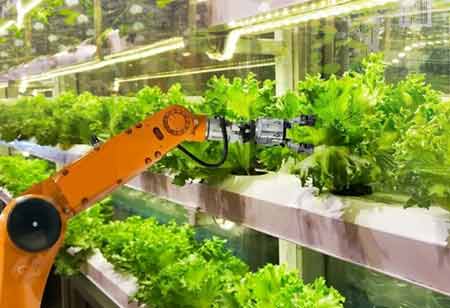Thank you for Subscribing to Agri Business Review Weekly Brief
Every Enterprise CIO Should Leverage to Yield More Profits-Top 4 Agriculture Technologies
AgTech can transform farm operations, especially small ones.

By
Agri Business Review | Monday, April 25, 2022
Stay ahead of the industry with exclusive feature stories on the top companies, expert insights and the latest news delivered straight to your inbox. Subscribe today.
The agriculture industry has begun to leverage innovative technology to revolutionize the agriculture field by gaining profit and completing the work.
FREMONT, CA: AgTech can transform farm operations, especially small ones. To maintain a world population expected to reach 10 billion by 2050, enterprises need to double the world's agricultural production. In addition, several global trends are emerging, influencing food security, poverty, and the overall sustainability of food and agricultural systems and leveraging digital technology. Here are four AgTech trends to watch out for in the coming years.
Blockchain
Even though blockchain technology is related to virtual currencies, the technology has a huge application and has the potential to transform traceability for food. Blockchain minimizes the inefficiencies and fraud and enhances and improves food safety, farmer pay, and transaction times. As food safety and authenticity is the first factor, the customers and farmers would focus alike. Blockchain gives the people pure and authoritative records of where their food has been and where it comes from. Furthermore, blockchain technology prevents price extortion and slow payments while eliminating the middleman and lowering transaction fees, which leads to better, fairer pricing and helps smallholder farmers attain a more significant part of their crop value.
Drones
The invention of drones is considered to help the agriculture sector in several ways. First, drone technology is used throughout the crop cycle for many tasks and operations, such as the following.
Crop spraying: Drones help scan the ground, spraying the crop in real-time for even coverage. The result of the spraying mechanism tends to be five times faster with drones than with traditional machinery.
Planting: The invention of drone technology and robotic planting systems have helped decrease planting costs by 85 percent. These systems permit shooting seeds and nutrients into the soil, enabling all nutrients necessary for the growing crops.
Health Assessment: Using both visible and near-infrared light, scanning a crop by drones helps notify the changes in plants by monitoring their health, alerting farmers of disease, and helping them take prompt action.
In a nutshell, drones can help maximize the inputs, react faster to threats, save time for crop surveying and real-time mapping, and aid in offering an estimate of yield.
Machine Learning and Analytics
It's observed that farmers spend lots of money per annum on seeds and fertilizers. Still, they lack reliable information about deciding which seed to buy and which fertilizer or nutrient will give a better yield in a particular region. AI (Artificial intelligence) and machine learning play a significant role here. Machine learning and analytics are used to get data for trends in every sector, and the agriculture sector is no exception. For example, machine learning predicts which traits and genes will be the best for the production of crops, giving farmers the best breed for their location and climate. Machine learning techniques use satellite data to differentiate the crops. The method also provides valuable information for crop insurance, logistics, and commodity markets. The convergence of robotics and data from an increasingly connected farm will accelerate this trend further. As technology and its innovation increase, it becomes powerful. Machine learning and advanced data analytics enable the processing of a huge amount of data.
Internet of Things (IoT)
The IoT (Internet of Things) has been verified to be a revolutionizing technology for many sectors and agriculture. Several remote sensing techniques, from in-field sensors to drones to satellite imagery, allow farmers to view their crops differently. With the data networks like 4G, computing, and sensor technology, farmers can now get access to a broad area with field-level detail. For example, sensors can monitor moisture levels, soil conditions, sunlight, wind speed, and other factors, whereas the sensors on animals can track health, location, fertility, and progress. The future of agriculture is the associated farm, and new lightweight sensors can provide farmers with far deeper and more accurate insights into every part of their farm operation.
Agriculture will no longer depend on uniformly applying water, fertilizers, and pesticides across fields. Instead, farmers will use the lowest quantities and target specific areas. In addition, future agriculture will use technologies such as machine learning, temperature sensors, aerial images, and drones.
See Also : Enterprise Search Solutions Companies





